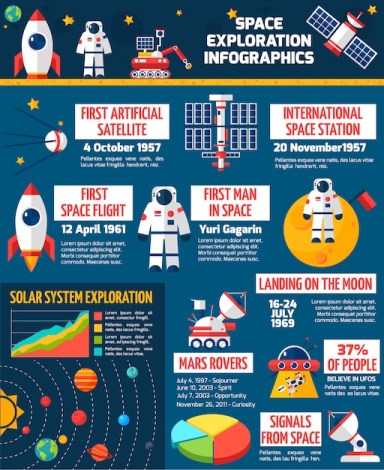Awesome Space Facts

Space is completely silent because there is no air or atmosphere to carry sound waves.
Astronauts can grow taller in space due to the absence of gravity compressing their spines.
In space, you can’t cry because tears don’t fall without gravity.
The sun is so big that more than one million Earths could fit inside it.
Stars twinkle because their light has to pass through Earth’s atmosphere, causing it to scatter.
The Moon is gradually moving away from Earth at a rate of about 3.8 centimeters per year.
There are black holes in space where gravity is so strong that nothing can escape, not even light.
The largest volcano in the known universe is on Mars and it’s called Olympus Mons.
Saturn’s density is so low that it could float on water.
Astronauts on the International Space Station witness an average of 16 sunrises and sunsets every day.
The Great Red Spot on Jupiter is a massive storm that has been raging for over 400 years.
The first living creatures to reach space were fruit flies, sent by America in 1947.
The tallest mountain in our solar system is on Mars and it’s called Olympus Mons.
Neutron stars are so dense that a teaspoon of their material would weigh about 6 billion tons on Earth.
Space is not as empty as it appears, and is filled with particles, radiation, and cosmic dust.
Venus has the longest day of any planet in our solar system, lasting about 243 Earth days.
Awesome Space Facts part 2
The Andromeda Galaxy is on a collision course with our Milky Way and is expected to merge with it in about 4 billion years.
A day on Uranus lasts just over 17 hours, while a year on Uranus lasts about 84 Earth years.
Some of the most stunning and colorful auroras occur on the gas giant planets like Jupiter and Saturn.
The biggest explosion ever observed in space was a gamma-ray burst, which released more energy in a few seconds than the Sun will emit in its entire lifetime.
The average temperature on the surface of the Moon can range from about 260 degrees Fahrenheit (-127 degrees Celsius) at night to 280 degrees Fahrenheit (138 degrees Celsius) during the day.
The Milky Way galaxy is estimated to contain about 100 billion stars.
The Voyager 1 spacecraft, launched in 1977, is the farthest man-made object from Earth and is currently traveling in interstellar space.
The surface gravity of Mars is about 38% of Earth’s, meaning you would weigh less on Mars.
The Hubble Space Telescope can see objects in space that are billions of light-years away, allowing scientists to study the early universe.
Space is not completely black; it actually has a faint glow called the cosmic microwave background radiation.
The first woman to travel to space was Valentina Tereshkova, a Russian cosmonaut, in 1963.
The largest planet in our solar system is Jupiter, which is more than 11 times the diameter of Earth.
One Mars year is about 687 Earth days.
The International Space Station travels at a speed of about 5 miles per second (28,000 kilometers per hour) in orbit around Earth.
Space is a vacuum, which means it doesn’t contain any air or matter.
The space between galaxies is not completely empty, but contains sparse gas and dust.
Mercury is the smallest planet in our solar system, even smaller than some moons.
The highest mountain on Mars, Olympus Mons, is nearly three times the height of Mount Everest.
The light from distant stars takes so long to reach us that we are actually seeing them as they appeared in the past.
There are about 170 billion galaxies in the observable universe.
The atmosphere of Venus is mostly carbon dioxide, making it a scorching hot planet with a runaway greenhouse effect.
Space travel can cause changes in astronauts’ vision due to the fluid shifts in their bodies in microgravity.
The closest galaxy to our Milky Way is the Andromeda Galaxy, located about 2.5 million light-years away.
The largest moon in our solar system is Ganymede, which is even bigger than the planet Mercury.
Uranus and Neptune are often called ice giants because a significant portion of their composition is made up of frozen gases.
The first human to walk on the Moon was Neil Armstrong, who said the famous words That’s one small step for man, one giant leap for mankind.
The space between Earth and the Moon is so vast that you could fit all the other planets in our solar system between them.
The Sun’s gravity is so strong that it keeps all the planets in our solar system, including Earth, in orbit around it.
Space exploration has led to many technological advancements on Earth, including satellite communication and GPS systems.

